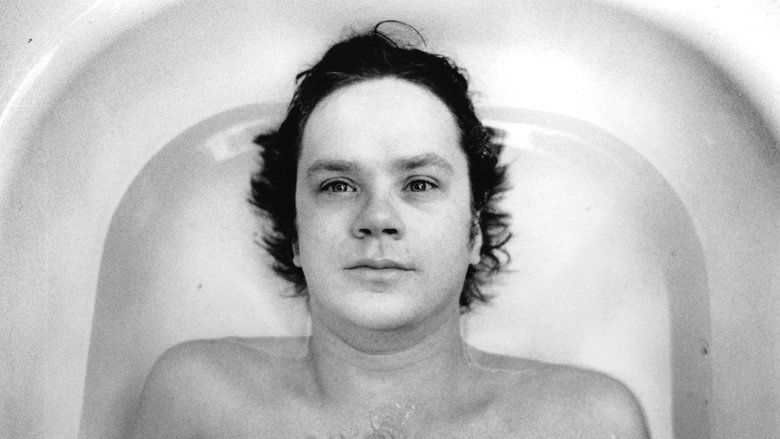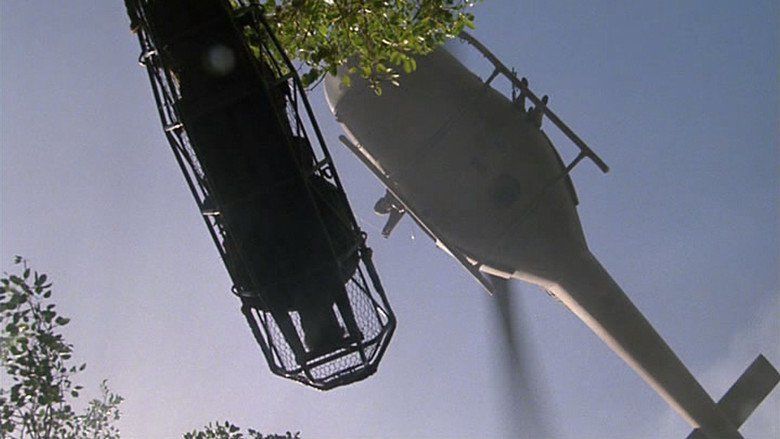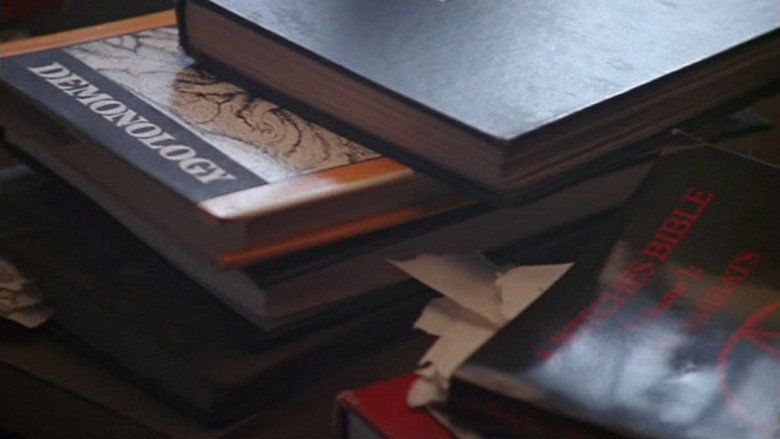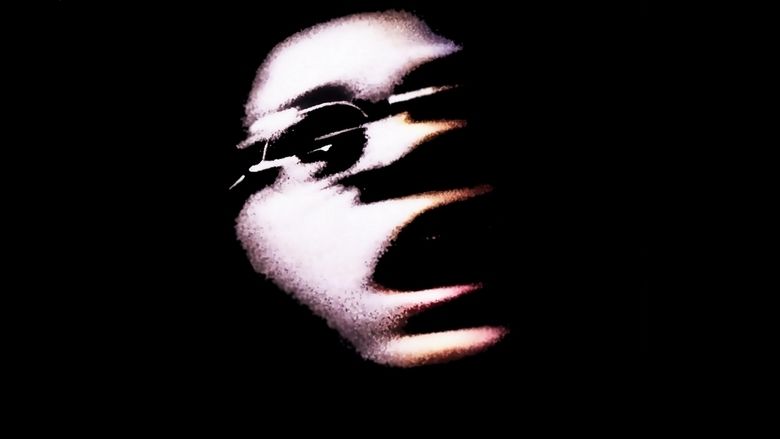Jacobs Ladder (film)
7.4 /10 1 Votes
3.5/4 Roger Ebert 62% Metacritic Genre Drama, Horror, Mystery Initial DVD release July 14, 1998 Writer Bruce Joel Rubin Language English | 7.5/10 IMDb 69% Rotten Tomatoes Director Adrian Lyne Screenplay Bruce Joel Rubin Duration Country United States | |||||||||||||||||||||||||||||||||
 | ||||||||||||||||||||||||||||||||||
Release date November 2, 1990 (1990-11-02) Cast Tim Robbins (Jacob Singer), Elizabeth Peña (Jezebel), Danny Aiello (Louis), Matt Craven (Michael), Pruitt Taylor Vince (Paul), Jason Alexander (Geary)Similar movies Silent Hill (2006), Soul Survivors (2001), The Others (2001), Pruitt Taylor Vince appears in Jacobs Ladder and Constantine, Legion Tagline The most frightening thing about Jacob Singer's nightmare is that he isn't dreaming. | ||||||||||||||||||||||||||||||||||
Jacob s ladder monsters of the week
Jacob's Ladder is a 1990 American psychological horror film directed by Adrian Lyne, produced by Alan Marshall, written by Bruce Joel Rubin and starring Tim Robbins, Elizabeth Peña, and Danny Aiello.
Contents
- Jacob s ladder monsters of the week
- Jacob s ladder what it all meant
- Plot
- Production
- Theatrical release
- Home media
- Box office
- Critical reception
- Influence
- Remake
- References

The film's protagonist, Jacob, is a Vietnam veteran whose experiences prior to and during the war result in strange, fragmentary flashbacks and bizarre hallucinations that continue to haunt him. As his ordeal worsens, Jacob desperately attempts to figure out the truth.

Jacob's Ladder was made by Carolco Pictures ten years after being written by Rubin. It drew from several inspirations for its story and effects, including the short film An Occurrence at Owl Creek Bridge and the paintings of Francis Bacon. Though only moderately successful upon release, the film garnered a cult following and became a source of influence for various other works such as the horror franchise Silent Hill. A loose remake was announced to be in works by LD Entertainment.

Jacob s ladder what it all meant
Plot

On 6 October 1971, American soldier Jacob Singer is with the 1st Air Cavalry Division, deployed in a village in the Mekong Delta during the Vietnam War, when his close-knit unit comes under attack. As many of Jacob’s comrades are killed or wounded, others exhibit abnormal behavior with some suffering catatonia, convulsions and seizures. A terrified Jacob flees into the jungle, only to be bayoneted in the gut by an unseen assailant.

Jacob is next seen awakening on a subway train in 1975. Despite having a PhD, Jacob works as a postal clerk and lives in a rundown apartment in Brooklyn with his girlfriend, Jezzie. Jacob misses his wife and their three sons, especially the youngest, Gabe, who was killed in a car crash before the war. He is increasingly beset by disturbing experiences and apparitions. An inexplicably locked subway exit results in him almost being run over by a train. He periodically glimpses faceless vibrating figures in the shadows and narrowly escapes being run over by a pursuing car. At a party thrown by friends, he appears to witness an enormous creature penetrating Jezzie before he collapses with a dangerous fever. Flashbacks to his time in Vietnam reveal Jacob being discovered, badly wounded, in the jungle by American soldiers before being evacuated under fire in a helicopter. At various times he also experiences visions of Gabe.

Paul, a member of his old unit, contacts him and reveals he is suffering similar terrifying experiences but is immediately killed when his car explodes. Jacob is dragged away from the wreckage by a bespectacled man. Commiserating after the funeral, the members of Jacob's old platoon confess that they have all been experiencing similarly horrifying hallucinations. Believing that they are suffering the effects of a military experiment performed on them without their knowledge or consent, the men hire a lawyer to investigate but he backs out of the case after reading military files documenting that the soldiers were never in combat and were discharged for psychological reasons. Jacob’s comrades soon apprehensively back down – Jacob angrily suspects they have been threatened into doing so. Jacob himself is later thrown into a car with intimidating men in suits who warn him against further investigation. He jumps from the moving car and is injured. He is taken to a hospital where he is restrained on a stretcher and wheeled down corridors full of grotesquely deformed patients before doctors, wielding barbaric metal instruments, inform him he is dead.

He is rescued from the hospital by his friend Louis who later quotes the 14th century Christian mystic Meister Eckhart:

Eckhart saw Hell too. He said: “The only thing that burns in Hell is the part of you that won’t let go of life, your memories, your attachments. They burn them all away. But they’re not punishing you”, he said. “They’re freeing your soul. So, if you’re frightened of dying and ... you’re holding on, you’ll see devils tearing your life away. But if you’ve made your peace, then the devils are really angels, freeing you from the earth.”
Jacob is approached by a distressed Michael Newman, the man who treated his wound in a medevac helicopter in Vietnam and who dragged him away from Paul’s burning car. Newman tells a story of having been a chemist with the Army’s chemical warfare division in Saigon. He designed “the Ladder”, a drug that massively increased aggression, taking people straight to their most primal urges. To test its effectiveness, a dose was secretly given to Jacob’s unit – causing them to turn on each other in a homicidal frenzy. The revelation causes Jacob to fully remember the moment he was attacked in Vietnam, where it is revealed that a fellow American soldier bayoneted him.
Finally given knowledge of what happened to him and why, in a calmer place, Jacob returns to his family's home. He sorts through his mementos, including his combat dog tags and honorable discharge. He is stunned to find Gabe at the foot of the stairwell who takes him by the hand and leads him up the steps into a bright light that engulfs the screen. In a wartime triage tent in 1971, military doctors fruitlessly treating Jacob reluctantly declare him dead after “putting up a Hell of a fight” and remark on the peaceful expression that has settled upon his face.
Production
The film's title refers to the biblical story of Jacob's Ladder, or the dream of a meeting place between Heaven and Earth (Genesis 28:12). Its little-known alternate title is Dante's Inferno, in a reference to Inferno by Dante Alighieri. Screenwriter and co-producer Bruce Joel Rubin perceived the film as a modern interpretation of the Liberation Through Hearing During the Intermediate State, the Tibetan Book of the Dead. Rubin said: "The inspiration in a sense is my entire spiritual upbringing. Once you have a meditative life you start to see that the world is really far different than what it appears to be. What appears to be finite is really couched in the infinite, and the infinite imbues everything in our lives." Before writing his scripts for Jacob's Ladder and Ghost, which too was released in 1990, the Jewish-born Rubin spent two years in a Tibetan Buddhist monastery in Nepal; previously, he has also written afterlife-themed Brainstorm and Deadly Friend. His original screenplay for Jacob's Ladder differs significantly at parts from the final film, especially towards the ending.
Rubin's work on Jacob's Ladder began in 1980, sparked by his nightmare in which he dreamt about being trapped in a subway. For several years, Rubin tried to sell the script, without success; Thom Mount of Universal Pictures said he "loved it, but it was not for his studio". Directors Michael Apted, Sidney Lumet and Ridley Scott all expressed an interest in making the film, but still no major studio was ready to invest in Rubin's "too metaphysical" stories as "Hollywood does not make ghost movies". Eventually, after Deadly Friend was filmed by Wes Craven in 1986, Rubin's screenplays for both Jacob's Ladder and Ghost were picked by Paramount Pictures. In 1988, Adrian Lyne, who described Rubin's work as "certainly one of the best scripts I've ever read", decided then to direct it instead of an adaptation of The Bonfire of the Vanities as he had originally planned (incidentally, Tom Hanks, an actor originally considered by Lyne for the role of Jacob, ended up starring in Bonfire). The ownership and policy changes at Paramount resulted in the cancellation of the project; the executives had doubts about the film's ending and the scenes taking place in Vietnam. The independent film studio Carolco Pictures decided to take over the production of Jacob's Ladder, giving Lyne a greater creative control and a budget of $25 million. Rubin became the film's co-producer, along with Mario Kassar, Alan Marshall and Andrew G. Vajna.
Lyne, who downplayed Rubin's "intimidating" Old Testament themes, said that he prepared for making the film by watching "endless" documentary films about the war in Vietnam and reading "countless" chronicles of near-death experiences. The film's plot device of a long period of subjective time passing in an instant has been explored by several authors. A particularly strong inspiration for both Rubin and Lyne was Robert Enrico's 1962 short film An Occurrence at Owl Creek Bridge, one of Lyne's favourite movies, which was in turn based on Ambrose Bierce's 1890 short story of the same name.
Hundreds of actors sought the main roles in the film, including Al Pacino, Dustin Hoffman and Richard Gere for Jacob, and Andie MacDowell, Julia Roberts and Madonna for Jezzie. Eventually, Tim Robbins and Elizabeth Peña were cast; both auditioned early and neither of them had starred in a feature film before. Robbins said the film presented for him "a great opportunity to go in a different direction. I love doing comedy, but I know I can do other things as well." The film's military advisor was Vietnam veteran Captain Dale Dye, who provided a five-day boot camp military training for the actors playing soldiers in the Vietnam storyline (including Robbins, Pruitt Taylor Vince, Eriq La Salle and Ving Rhames).
All of the film's special effect sequences were filmed in camera, with no use of post production effects. In several scenes of Jacob's Ladder, Lyne used a body horror technique in which an actor is recorded waving his head around at a low frame rate, resulting in horrifically fast motion when played back. In the Special Edition's commentary track, Lyne said he was inspired by the art of the painter Francis Bacon when developing the effect. In his screenplay, Rubin used traditional imagery of demons and hell. However, Lyne decided to use images similar to thalidomide deformities to achieve a greater shock effect. After many heated arguments, Lyne managed to convert Rubin to his vision. Lyne and Rubin used the works of the artist H. R. Giger and the photographers Diane Arbus and Joel-Peter Witkin for inspiration; another influence came from the Brothers Quay's 1986 stop motion short film Street of Crocodiles.
In the film, Jacob is told by Michael that the horrific events he experienced on his final day in Vietnam were the product of an experimental drug called "the Ladder", which was used on troops without their knowledge. At the end of the film, a message is displayed saying that reports of testing of BZ, NATO code for a deliriant and hallucinogen known as 3-quinuclidinyl benzilate, on U.S. soldiers during the Vietnam War were denied by the Pentagon. Lyne said a part of the inspiration for this motif was Martin A. Lee's book Acid Dreams: The CIA, LSD and Sixties Rebellion, but noted that "nothing in the book suggests that the drug BZ — a super-hallucinogen that has a tendency to elicit maniac behavior — was used on U.S. troops." However, CNN has reported on declassified documents showing that the U.S. Army tested BZ and other "psycho-chemical" agents on human subjects at Edgewood Arsenal in Maryland from 1955 to 1975.
The war scenes were filmed in Puerto Rico, in the area of Vega Baja, and the UH-1 helicopters were provided by the Puerto Rico National Guard.
According to Lyne's audio commentary, test screenings indicated that the initial version of the film was overwhelming for the audience. In response, about 20 minutes of disturbing scenes, mostly from the last third of the film, were removed from the final cut.
Theatrical release
Jacob's Ladder opened on November 2, 1990, distributed by TriStar Pictures. Jacob's Ladder: Original Motion Picture Soundtrack with the music by Maurice Jarre was released by Varèse Sarabande in 1993. Rubin's companion book, released by Applause Theater Book Publishers on the same day as the film, features a final draft of the screenplay, including the deleted scenes, and his essay on making of the screenplay and the film.
Home media
The Special Edition DVD was released by Artisan Entertainment on July 14, 1998, containing three deleted scenes ("Jezzie's Transformation", "The Antidote" and "The Train Station") along with several other special features, such as audio commentary by Adrian Lyne and a 26-minute making-of documentary "Building Jacob's Ladder". On September 14, 2010, the film was released on Blu-ray Disc by Lions Gate Entertainment and retains all of the special features of the DVD version, along with two trailers, omitting only a TV spot that came with the DVD.
Box office
The film took the number one spot at the weekend box office in North America, garnering ticket sales of $7.5 million from 1,052 screens. However, the attendance dropped fast and its overall domestic box office result was only $26,118,851.
Critical reception
According to aggregate website Rotten Tomatoes, 69% of reviews of the film were positive based on 61 reviews. Roger Ebert of the Chicago Sun-Times wrote that watching it left him "reeling with turmoil and confusion, with feelings of sadness and despair," and called it a "thoroughly painful and depressing experience - but, it must be said, one that has been powerfully written, directed and acted." He awarded the film three and a half out of a possible four stars. Janet Maslin of The New York Times wrote that this "slick, riveting, viscerally scary film about what in other hands would be a decidedly unsalable subject, namely death," is "both quaint and devastating." However, Desson Thomson of The Washington Post felt disappointed with the film that is "ultimately flat on its surrealistic face, the victim of too many fake-art sequences." Owen Gleiberman of Entertainment Weekly wrote that "Jacob's Ladder is so 'dark' it sucks Robbins right down with it. By the time Jacob is being strapped to a bed and wheeled down a hospital corridor strewn with bloody limbs, it's hard to care whether the Orwellian image is a hallucination or not. You just want out." Kim Newman called the film "effectively the blunt remake" of Carnival of Souls.
According to IGN's review of the DVD release in 2004, "After movies like Se7en, it may not pack the same subtle horror for today's audiences it did when it was first released, but it's still a great film." IGN's review of Jacob's Ladder's 2010 Blu-ray release called it is "an emotionally poignant, creepy horror masterpiece." According to Slant Magazine, Jacob's Ladder is "a bizarrely cohesive hybrid of war movie, character study, art film, and horror flick" and "the very act of watching the film is so emotionally draining that the viewer leaves the film feeling worked-in; the thought of repeat viewings is daunting yet insatiable." In 2011, John Kenneth Muir called the film's nightmarish hospital scene "one of the most terrifying moments in all of 1990s horror cinema." Muir further wrote: "In its musings about death, about the end we all fear, Jacob's Ladder proves a deeply affecting and meaningful motion picture. After a screening, you'll immediately want to hug the people you love and then go outside and breathe the fresh air, or otherwise affirm your very existence."
The film's screenplay was included on the list of "Hollywood's ten best unproduced screenplays" by American Film magazine in 1983. In 1991, Jacob's Ladder was nominated at Horror Hall of Fame II for best horror film, losing to The Silence of the Lambs. The film was also featured in Bravo's 2004 documentary miniseries The 100 Scariest Movie Moments and in the 2009 book 1001 Movies You Must See Before You Die. In 2012, Total Film ranked it as the 31st best independent horror film of all time. That same year, the film's elements were included on the list of top ten scariest movie demons by CraveOnline and ranked as the 19th best movie plot twist by Complex; similarly, it was also included on the 2013 list of 20 shocking movie plot twists by Digital Spy. In 2013, Slate ranked it as the 146th greatest horror film of all time, the Jacob Burns Film Center Projectionist Andrew Robinson chose it as his favourite scary movie, and IGN's Lucy O'Brien wrote a feature article about this "brilliant" film, where she called it "the movie every survival horror fan should watch".
Influence
Jacob's Ladder greatly inspired the horror fiction franchise Silent Hill, including the video games Silent Hill (1999), Silent Hill 2 (2001), Silent Hill 3 (2003) and Silent Hill: Homecoming (2007), as well as the series' 2006 film adaptation by Christophe Gans. Kim Manners prepared for directing The X-Files episode "Grotesque" by listening to the music from Jacob's Ladder. The film's influence on their works was recognised by Ryan Murphy, writer of the 2011 TV series American Horror Story: Asylum, and Shinji Mikami, director of the video game The Evil Within. Jacob's Ladder as a film is directly referenced in Silent Hill 3, in particular the "twitching" effect, as well as one of the game's destinations is Bergen Street station, as well as in the 2002 The Twilight Zone episode "Night Route", the 2005 film Wallace & Gromit: The Curse of the Were-Rabbit and the 2010 The Simpsons episode "The Squirt and the Whale".
In 1991, Claytown Troupe used a sample of Newman's quote "It's a fast trip..." at the beginning of the track "Rainbow's Edge" in their album Out There. The band UNKLE sampled dialogue from the film in their 1998 song "Rabbit in Your Headlights" and again in 2003 in the song "Inside". VNV Nation's track "Forsaken" from the 1998 album Praise the Fallen ends with the quotation from Eckhart, while "Devils" from IVardensphere's 2011 album APOK begins with the same quotation; a sample of Jacob's yell "Stop it, you're killing me!" is used in the song "Next in Line" in Nevermore's 1996 album The Politics of Ecstasy. The music video for the 2010 song "Nightmare" by Avenged Sevenfold is a homage to the famous hospital scene from the film, chosen because the band's deceased drummer The Rev was a fan of the film. One of the directors of Linkin Park's music video "Papercut" stated that "some inspiration for the video was taken from the film Jacob's Ladder, especially with the twitching blue man in one of the rooms of the house".
Scholars have seen the film's influence in works ranging from M. Night Shyamalan's 1999 hit psychological horror film The Sixth Sense to Peter Arnett's controversial 1998 CNN report "Valley of Death" about the Vietnam War's 1970 Operation Tailwind. Jeff Millar of Houston Chronicle wrote that Giuseppe Tornatore's 1994 psychological thriller A Pure Formality uses the plot device of Jacob's Ladder mixed with several other sources. According to Premiere, Massy Tadjedin's 2005 psychological thriller The Jacket "is a film for those who don't remember Jacob's Ladder, perhaps for someone like Jacob himself", as it "resembles Jacob's Ladder too much for its own good". PopMatters called Michael Hurst's 2006 horror film Room 6 a "Jacob's Ladder lift". Adam Gierasch's 2014 horror film Fractured was "described as a classic film noir with a Jacob's Ladder-like vibe".
Remake
In 2013, Jeff Buhler (The Midnight Meat Train) was reported as writing a script for LD Entertainment's new version of Jacob's Ladder, which is based on an earlier draft by Jake Wade Wall. According to The Hollywood Reporter, "the producers are looking to make something more akin to an homage and not mimic the original. The plan is to contemporize the story with new situations and characters but still maintain a story that examines issues and poses existential questions." James Foley has been attached to direct the project.
Buhler said that since, due to two recent wars, the American "cultural understanding of the experience of warfare and what it does to people mentally" has become "a completely different place than it was" in 1990, he decided to not be "necessarily going to the same conclusion, and finding a new way to give the audience an experience that is similar in terms of impact and feeling, but that doesn’t play the same tune. It was a very tricky situation in the sense that we were trying to recreate something, but honor the spirit and concept (of the original), while telling a different story."
On March 21, 2016, Deadline.com announced that LD Entertainment has greenlit a "re-imagining" of the 1990 supernatural thriller Jacob's Ladder. The film will star Michael Ealy, with Nicole Beharie and Jesse Williams, and be directed by David M. Rosenthal, who directed Ealy in the 2015 thriller The Perfect Guy. Co-produced by Gaeta/Rosenzweig Films and Will Packer Productions, and written by Jeff Buhler and Sarah Thorp, the remake is described as a "modern-day paranoid action thriller about two brothers." Principal photography on the film is scheduled to begin in May 2016.
References
Jacob's Ladder (film) WikipediaJacobs Ladder (film) IMDbJacobs Ladder (film) Roger EbertJacobs Ladder (film) Rotten TomatoesJacobs Ladder (film) MetacriticJacobs Ladder (film) themoviedb.org
